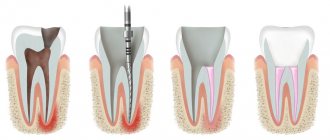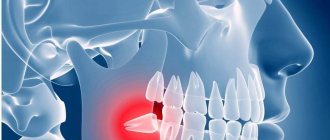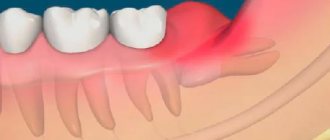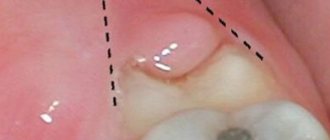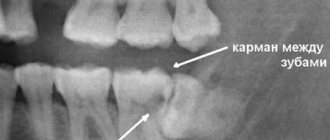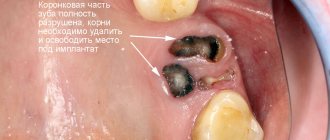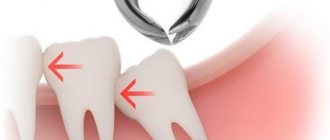From this article you will learn:
- how wisdom teeth are removed - photos and videos,
- how painful it is, what complications there are,
- price for wisdom tooth removal in Moscow.
The article was written by a dental surgeon with more than 19 years of experience.
Removing a wisdom tooth in dentistry - in half of the cases, is a complex surgical operation, which is associated with the difficulty of extracting the tooth from the dental alveoli (for example, due to severely curved roots or abnormal position in the jaw). Of all the human teeth, it is the eruption of wisdom teeth that causes patients the most discomfort, which usually happens when there is not enough space in the dentition for their eruption. And in this case, their removal also helps prevent crowding of the front teeth.
The times when dental surgeons hollowed out wisdom teeth using a surgical chisel and hammer are long gone. And even more so, none of the dentists use such a weak anesthetic as novocaine for pain relief. Currently, if a wisdom tooth is in such a position that it cannot be removed entirely from the jaw (without causing significant injury to the surrounding tissues), the doctor uses a special water-cooled drill. This allows you to separate the tooth into parts, quickly removing the roots individually.
Removal of the eighth tooth (wisdom tooth) –
The decision to remove already erupted wisdom teeth is made based on the possibility and necessity of using them for prosthetics in the future. It is very easy to remove a wisdom tooth, but effectively restoring the end defects of the dentition (if you do not have 6-7-8 teeth) can only be done with dental implantation. Therefore, sometimes even a severely damaged eighth tooth is worth restoring in order to later use it as a support for a bridge or to improve the fixation of removable dentures.
If we are talking about removing wisdom teeth that have not yet erupted (or partially erupted), then in adolescents it is optimal for the orthodontist to make the decision. The rudiments of the eighth teeth are formed in children aged 4-5 years, while the formation of the crown part ends at approximately 12 years, and the complete formation of roots - only at 24 years. If necessary, a teenager can have his unerupted eighth teeth removed, i.e. with not yet fully formed roots.
Is it painful to remove a wisdom tooth?
The most common question we hear from patients is whether it hurts to remove a wisdom tooth. Correctly administered anesthesia by a doctor eliminates pain during the removal process (of course, if you do not abuse analgesics, as well as alcohol and drugs). However, in the comments to this article you can read that the reviews of a small part of patients about wisdom tooth removal say that they experience severe pain and that “never again in their life.” And as an experienced dental surgeon, I will comment on this in detail.
- Pain during tooth extraction – this most often happens when a wisdom tooth is removed from the lower jaw. The fact is that in this case, so-called “mandibular” (torusal) anesthesia is administered. This type of pain relief is quite complicated, because... the tip of the needle should be located strictly at a certain point - approximately in the middle of the inner surface of the lower jaw branch. This is where the nerve that innervates the teeth on this side of the lower jaw passes. Removal will be painful when the doctor is not very experienced or hastened.
Thorusal anesthesia (technique) –In this case, the following will indicate a well-placed anesthesia: half of the lower lip on this side, as well as the tip of the tongue, should become very numb. Numbness occurs in about 5-10 minutes, after which the doctor usually asks you whether your lip and tongue are numb. If the numbness is weak, it is better to ask the doctor to give another injection of anesthetic. It is better to use drugs based on articaine as anesthetics (for example, Ultracaine containing vasoconstrictors). If you were given regular lidocaine without vasoconstrictors, the effectiveness of anesthesia will be lower.
But removing a wisdom tooth in the upper jaw does not require complex anesthesia techniques. In the upper jaw, the bone is quite soft and porous, so the anesthetic easily penetrates through the bone tissue. The injection is made into the gum - approximately in the projection of the roots of the upper wisdom tooth. After administration of the anesthetic, pain relief occurs within just 5 minutes and usually lasts from 15 to 45 minutes (depending on the choice of anesthetic). The usual symptoms you should experience are numbness in the cheek and part of the roof of your mouth.
- Pain after tooth extraction – when patients complain of pain associated with the removal of wisdom teeth, in 90% of cases this is pain that occurs after the removal. In this case, the reason is severe tissue trauma during a complex extraction, or as a result of the development of inflammation of the socket of the extracted tooth. Unfortunately, sometimes a quick 5-minute procedure for removing a wisdom tooth often ends in a week of nightmare, which occurs due to alveolitis of the socket of the extracted tooth. In some cases, it is the patients themselves who are to blame for not following the doctor’s recommendations after removal.
To summarize, the removal process itself is more scary than painful. In this case, the pain begins after removal, and it can be associated either with the excessive trauma of the removal (i.e., the doctor did not perform the operation quite competently), or with the fact that the patient could rinse out a blood clot from the wound. Well, we also forgot to say that there is another option for removing a wisdom tooth - this is removal under general anesthesia (not too pleasant, but not scary).
Types of operations
Depending on the position of the tooth in the gum, the anatomy of the roots and the degree of crown eruption, removal can be:
- Simple Indicated if the molar has erupted without pathologies and has a root system of normal configuration. Using an ultrasonic scalpel, the tooth is separated from the ligaments and fibers holding it in place and removed. The procedure lasts from 10 to 30 minutes.
- Complex Used for anomalies in the eruption of the figure eight, incorrect position in the jaw, branching of the root system. The tooth and roots are divided into fragments and removed. The operation can take up to 1 hour.
How do dental surgeons remove wisdom teeth?
Typically, removing an upper wisdom tooth is easier than removing a lower wisdom tooth. This is due to the fact that the bone tissue of the upper jaw is softer and more porous, and therefore it is much more difficult to break off one of the roots (when removing a tooth from the socket). However, on the other hand, if the doctor does break off the top of one of the roots, then removing it from the upper jaw will be much more difficult. The latter is due both to the lack of good visual access and to the fact that working with thin elevators necessary to extract the root apex from the socket is much more dangerous in soft bone.
The bone tissue of the lower jaw is much denser, and lower wisdom teeth almost always have massive and/or often curved roots. Therefore, the roots of the lower wisdom teeth generally break off more often than the upper ones. But the doctor always has the opportunity to reduce the risk of such an outcome by taking an x-ray that will show us the shape and position of the roots in the jaw. If there is a risk of breaking off the root during tooth extraction, a good doctor will first saw it into pieces, after which he will separately remove the roots and parts of the crown. All this usually takes less than 15 minutes, but you come to understand this with experience.
But most often you can find a different picture, when the doctor uses all his might to loosen the tooth with forceps or tries to dislocate the tooth from the socket with an elevator, but one of the roots suddenly breaks off. Then the doctor begins to either pick at the wound for a long time with a thin elevator, or drill out the bone tissue (to get to the broken off tip of the root). In both cases, very significant trauma is caused to the jaw, which will lead to severe pain and inflammation of the wound in the postoperative period. Therefore, experience and understanding of the extraction strategy play a big role, and sometimes even a very complex tooth, on which one doctor can spend a whole hour, another may need only 5-10 minutes.
Simple and complex wisdom tooth removal –
Thus, removing the eighth tooth can be either simple or complex. In some cases, we can assume in advance that there will be a difficult removal. Here are a few options at a glance: 1) we need to remove a tooth that has not yet erupted above the mucous membrane, 2) on the x-ray we see curved roots, 3) the tooth has a strong slope towards the 7th tooth, resting against it with the crown in the cervical area, 4) the tooth has a horizontal position in the jaw, 5) the crown of the tooth is almost completely destroyed and there is no way to “catch” on it with instruments.
Variants of the position of the wisdom tooth in the jaw -
With similar options for the position of the wisdom tooth (as in the radiographs above), we plan a complex extraction in advance. But even removing such teeth with the right strategy may not be too difficult, taking only 15-20 minutes. Below we will describe in detail how simple wisdom tooth removal is carried out, and also show one of the options for complex removal.
Do I need to remove uncut “eights”?
Not all people develop their “8s” by the right age. Sometimes they remain in the anlage, that is, retained (not erupted). When to remove them:
- if on an x-ray we see that the wisdom teeth abut adjacent molars (seventh teeth). There is a risk that wisdom teeth will “eat” into an adjacent tooth inside the bone. And then you will have to remove 2 teeth.
- The pressure of the “eights” on neighboring teeth can cause caries of the root of the “sevens” - our main chewing teeth.
- If the wisdom teeth are large and there is no place for them in the oral cavity. There is a high risk that they will collide with the dentition, and a crowded position of the front teeth will appear.
- During implantation next to unerupted figure eights. It is worth removing the tooth so that it cannot damage the implant in the future.
Simple wisdom tooth removal -
In video 1 below you can see how the lower wisdom tooth is removed.
Please note that before loosening the tooth using forceps, the doctor used a special tool to separate the gum mucosa from the neck of the tooth. Thus, the entire removal process took only a few minutes, plus another 1-2 minutes will be required to apply 1-2 stitches. Video 2 shows how the removal of an upper wisdom tooth is performed. Please note that removal is carried out with a special tool (elevator), which looks like a large screwdriver. With the help of an elevator, the wisdom tooth is dislocated from the socket, and forceps are used only to remove the moving tooth from the socket (24stoma.ru).
Important points that will allow you to avoid complications...
- When taking your medical history, the most important thing you should tell your doctor about is: allergies to medications, diabetes, bronchial asthma, problems with blood pressure, bleeding disorders, whether you are taking anticoagulants.
If you took Aspirin within 1 week before, then this should also be mentioned, because it thins the blood and thereby contributes to the development of bleeding and the formation of hematomas. It is very important for women to inform the doctor about their critical days. The fact is that during menstruation, the number of platelets in the blood decreases by 30-50%, and stopping bleeding depends on them. If this is not taken into account (and the doctor does not suture the wound), you can get severe bleeding, and not necessarily right away in the doctor’s chair, but when you come home.
- After removing the tooth from the socket, simple removal does not involve making incisions in the gums or drilling the tooth out of the bone tissue. The tooth is rocked with forceps or an elevator and removed. After extraction, a good doctor will always put the drug Alvogel into the socket of the extracted tooth, which will reduce the risk of developing alveolitis (inflammation of the socket of the extracted tooth). This common drug is available in every clinic.
- Stitching - after simple removal, doctors rarely sutured the wound.
But a good doctor will always put stitches to bring the edges of the wound (mucous membrane) closer together, even after a simple removal. Studies have shown that this step almost completely eliminates the risk of bleeding or clot falling out of the wound, and the wound will hurt significantly less after removal. But the most important thing is that the risk of developing alveolitis is reduced by 70-90%. Therefore, I advise you - even before removal, ask the doctor to put 1-2 stitches on you, even if you have to pay extra for it. Believe me, in the end, thanks to this, you will save yourself a lot of nerves and money on medications and repeated visits to the doctor (if bleeding or inflammation of the hole develops). For assignments after deletion, see the end of the article.
How complex removal can sometimes be made simple -
We want to show you another video where an impacted tooth that has not yet fully erupted is removed. Despite the fact that the doctor makes an incision in the mucous membrane and saws out the bone tissue around the tooth with a drill, removal takes only 5 minutes. Please note that in this case, the tooth is not removed using forceps, but the tooth is again dislocated from the socket using an elevator. This video clearly demonstrates that a good doctor is often able to turn a complex removal into a simple one.
Complex wisdom tooth removal –
In cases where the tooth has not yet erupted, or it has numerous branched and curved roots, or when the crown of the tooth is almost completely destroyed (there is nothing to grab with forceps), or the tooth has a strong slope or occupies a horizontal position - all this suggests that removal can be difficult. And here, of course, it is advisable to have an x-ray.
Complex removal always involves a number of steps. In this case, the doctor will make an incision in the gum, or saw the crown of the tooth into 2 parts (in order to then extract the roots separately). Complex removal may involve drilling out the bone tissue to facilitate loosening and removal of the tooth from the socket, or to get to the top of one of the roots broken off in the wound. Accordingly, at the end we will definitely need to apply several stitches.
Complex wisdom tooth removal (Fig. 4-8) –
Description of the operation - after anesthesia, an incision is made in the mucous membrane of the gum, and the edges of the mucous membrane are moved back to expose the crown of the tooth and the bone tissue around it. Further, sometimes we can immediately dislocate a tooth with an elevator, but sometimes we first have to cut it into several parts with a drill, or first drill out the bone tissue around the tooth with a drill. Next, using an elevator, we loosen the tooth and remove it from the socket.
Next, the wound is washed with antiseptics and the anti-inflammatory medicine Alvogel is placed in the hole. The fact that it was placed in your hole is always indicated by a specific iodine smell and taste. This medicine dissolves on its own after 7 days, i.e. you don’t have to remove it from the hole. After this, the wound is sutured. The suture material may be self-absorbing (within 7-10 days), or you will have to return to the clinic to remove the sutures.
Complex removal of the lower wisdom tooth (video) –
In video 1 below, you can see that the doctor first completely saws off the crown of the tooth with a drill, and only after that removes the roots of the tooth. In this case, this is necessary for the reason that the wisdom tooth is located at a strong angle to the 7th tooth in front, resting against it in the cervical area (this will not allow the 8th tooth to be removed from the socket without breaking its roots). In video 2, the doctor saws the crown of the tooth into two parts, after which he extracts the roots separately.
Important: it should be noted that after the removal of wisdom teeth, inflammation of the socket (alveolitis) develops in 25-30% of the sockets of the extracted teeth. After the removal of teeth of any other location, such inflammation develops only in 2-5% of cases. Therefore, it is very important to provide antiseptic treatment of the wound after a complex removal, place an alvogel in the hole, apply sutures, and also make sure that a blood clot forms in the hole.
Symptoms of dystopia of the 3rd molar
It is impossible to visually or tactilely determine the position of the growing figure eight. Among the symptoms indicating abnormal growth of this dental unit are:
- inflammation of gum tissue;
- the appearance of a “hood” of soft tissues;
- dull pain in the jaw;
- painful pressure on the root of an adjacent tooth;
- acute pain in the area of the second molar;
- enlargement of the submandibular lymph nodes;
- inflammation of the trigeminal nerve (pain in the jaw, back of the head, ear).
It is important not to try to diagnose yourself, but to go straight to the doctor. Among the methods for diagnosing this anomaly, the most effective are:
- radiography - an x-ray of the affected area;
- orthopantomogram - panoramic x-ray of the jaw;
- cone beam tomogram - used in severe cases.
Diagnostics using special medical equipment allows you to most accurately determine the position of the dental unit, the condition of the roots and bone tissue. Based on the diagnostic results obtained, the dentist makes a decision on methods of treatment or extraction of the problem tooth.
How much does it cost to remove a wisdom tooth: price in Moscow
How much does it cost to remove a wisdom tooth: the price in Moscow will depend on the complexity of the removal, as well as on the pricing policy of the dental clinic. For example, the cost of wisdom tooth removal can differ significantly in public clinics and private economy class clinics - from the price in clinics of medium and high price categories.
In addition, in some clinics there may be a gradation of wisdom tooth removal only into simple and complex, while in others - into simple, medium complexity and complex. After analyzing the prices, we divided them into economy class clinics and clinics in the middle and high price segment.
Wisdom tooth removal: price in economy class clinics in Moscow
- A simple removal of a wisdom tooth costs from 1,500 rubles, the cost already includes anesthesia, but if you need to put 1-2 stitches, you will have to pay another + 500 rubles.
- Removal of average complexity costs about 3,000 rubles, this price includes anesthesia and suturing.
- Complex wisdom tooth removal - from 5,000 rubles, this includes the removal of impacted and dystopic wisdom teeth. The price is already “all inclusive”, including anesthesia, repeat examinations and suture removal.
The price of wisdom tooth removal in clinics of the middle and upper price segment is –
- Simple removal – from 3500 rubles.
- Complex removal costs about 10,000 rubles, this price is also “all inclusive”, including repeated examinations.
How is it removed?
If you go to a private dental clinic, the procedure will be absolutely painless for the patient. Usually, good medical centers give preference to low-traumatic methods, that is, they perform surgery using a laser or ultrasound. Thus, the procedure is carried out practically without blood, and the healing process is accelerated several times. Keep in mind that such methods will have a higher price compared to the classic removal method.
Recommendations after wisdom tooth removal –
After a simple extraction, it is enough to follow the standard recommendations after tooth extraction. But what to do after the removal of a wisdom tooth, if the removal was difficult or was carried out against the background of purulent inflammation. To the standard recommendations in the link above, we recommend adding the following -
NSAID-based analgesics - without waiting for the anesthesia to wear off, take an NSAID-based analgesic (for example, ibuprofen). The advantage of these drugs is that in addition to pain relief, they also have an anti-inflammatory effect. Be sure to drink on day 1, then as needed. And remember that after removal you cannot take aspirin and its derivatives.
- Antihistamines - they are also called antiallergic. We recommend taking it (preferably Suprastin) once a day before bedtime in the first 3 days after a complex removal. The advantage of these products is that they help reduce the swelling of soft tissues, which will certainly develop after a complex removal.
- Antibiotics – Antibiotics after wisdom tooth removal should only be prescribed by a dental surgeon and not taken on your own. Most often, dental surgeons are accustomed to prescribing Lincomycin 0.25 capsules (2 capsules 3 times a day, for 5 days). This is an inexpensive Russian drug, quite effective, but it has a strong effect on the intestinal microflora, killing all living things.
Another popular antibiotic in dentistry is Amoxiclav. For adults, it is necessary to use Amoxiclav tablets containing 500 mg of amoxicillin and 125 mg of clavulanic acid - 2 times a day. However, if you have had stomach upsets (diarrhea) after taking antibiotics, then it is better to opt for the antibiotic Unidox-solutab 100 mg 2 times a day for 5-6 days.We recommend the latter option. And try never to take Russian antibiotics in your life if possible, if you do not want to develop pseudomembranous colitis. It would be better then to give preference to inexpensive Indian antibiotics.
Wisdom tooth removal: consequences, complications
As we have already said: there are much fewer complications if, even after a simple removal, the doctor always sutures the wound. Below we will also list all the main complications after wisdom tooth removal, which (we must admit) in most cases are the cause of the following doctor errors -
- Wrong strategy - inexperienced or lazy doctors try, if possible, to remove a wisdom tooth only with forceps and an elevator, sometimes torturing the patient for 1-2 hours, instead of immediately making an incision and sawing out a small amount of bone, or sawing the tooth crown into several parts, removing this is each root separately.
- Poor instrumentation - if you see that the doctor is using a chisel, then it is almost natural that you will then have complications (inflammation of the socket, pain in the temporomandibular joint, numbness of the lower lip due to nerve injury). Gouging out is simply unacceptable. Sawing of roots and bone should only be done with a water-cooled drill (the absence of water cooling in 100% of cases leads to overheating of the bone and the development of inflammation of the socket).
- Incorrect prescriptions after extraction - after any complex extraction, especially one carried out with sawing out the bone, sawing the crown of the tooth, as well as even after a simple extraction, but if the tooth was removed due to inflammation, it is necessary to prescribe antibiotics. Some doctors do not do this, resulting in inflammation of the extracted tooth socket after 1-2 days.
The most common complications are
- Bleeding after removal - sometimes bleeding does not develop in the doctor’s chair, but several hours after removal or even at night. There are special methods for stopping bleeding at home that help most patients.
- If numbness of the lower lip appears, this indicates an injury to the mandibular nerve, which passes near the tips of the roots of the lower teeth. In this case, you need to urgently contact a dentist and neurologist.
- Inflammation of the socket of an extracted tooth is the most common complication, which is commonly called alveolitis. Symptoms are aching pain, which can be moderate or moderate in severity. If after removal your pain/swelling does not decrease, but only increases, if you experience pain when cold or hot water gets on the wound, if there is an unpleasant odor from the socket, if there is no clot in the socket and food gets stuffed there - all this is typical for alveolitis .
How to prepare for removal
If the process of the emergence of the third molar causes concern or is accompanied by pain, then it is necessary to show the problem unit to the dentist as soon as possible. You should not postpone a visit to the clinic, abuse painkillers or use “miracle” folk remedies - this will not help solve the problem and may worsen it.
After treatment, there are 2 possible scenarios - the wisdom tooth will be treated or removed. To properly prepare for removal, just follow a few simple recommendations.
- 1 - 2 days before the procedure, stop taking alcohol and anticoagulants - drugs that impair blood clotting, for example, Aspirin, Heparin, Ibuprofen.
- On the eve of the operation, it is better not to practice warming procedures - go to the bathhouse, sauna, solarium, or steam your feet.
- Be sure to eat 1 – 2 hours before removal.
- Before visiting a doctor, thoroughly brush your teeth and mouth with a regular toothbrush and toothpaste.
Immediately before removing a wisdom tooth, it is recommended to lubricate your lips with Vaseline or hygienic lipstick - this will protect them from the formation of cracks. As a rule, in good clinics the dentists do this themselves, but just in case, it is better to take the product with you from home.
It is important to know! According to the observations of dentists, seeking help earlier guarantees a less painful procedure.
This is due to the fact that the place where the figure eight appears is not yet “exhausted” by pain, slightly inflamed, without swelling and other unpleasant symptoms. In this case, an injection of anesthesia will be sufficient to completely numb the procedure.
If you endured it for a long time, took pills, and then couldn’t stand the torment and asked for help, then you need to be prepared for the fact that, most likely, the operation will be more painful and the dentist will have to use a larger dose of anesthesia, which is not always possible.
Regardless of the time of treatment, it is necessary to understand that figure eight extraction is a rather complex process from a technical point of view, requiring the efforts of a doctor. Naturally, tooth extraction will be accompanied by unpleasant sensations. The degree of their manifestation depends on the patient’s pain threshold - therefore it is better to warn the specialist in advance about the characteristics of your body.
What do patient reviews depend on?
Positive reviews will primarily depend on the experience and professionalism of the dental surgeon. It is better to find an experienced doctor rather than a young doctor straight out of medical school. Ideally, the doctor has experience in maxillofacial surgery and/or implantology. Read patient reviews about wisdom teeth removal in the comments to this article. We hope that our article on the topic: Wisdom tooth removal consequences photo - was useful to you!
Sources:
1. Higher prof. the author’s education in surgical dentistry, 2. Based on personal experience as a dental surgeon, 3. National Library of Medicine (USA), 4. “Outpatient surgical dentistry” (Bezrukov V.), 5. “Qualified removal of third molars” (Asanami WITH.).
What drugs are used for pain relief
Just a few decades ago, the only painkiller used by dentists was novocaine. Despite its low toxicity, it very often caused serious complications in patients: from an allergic reaction to anaphylactic shock.
The next step was the use of lidocaine. It is still used to this day in budget dental offices, and has an undeniable advantage: allergies to the drug occur extremely rarely. The problem is different: to prolong the effect of lidocaine, the dentist has to add a drop of adrenaline to it. Moreover, this is done “by eye”. And as soon as the doctor’s hand trembles a little, the patient is guaranteed such unpleasant symptoms as rapid heartbeat and dizziness.
It is much more comfortable for both the doctor and the patient of the dental clinic to deal with articaine anesthetics. These include:
- ubistezin;
- ultracaine;
- septanest.
Firstly, such drugs are administered with a carpule syringe, which ensures that the injection itself is less painful. Secondly, the ratio of adrenaline and anesthetic in the drugs is adjusted to the nearest milliliter. This means that wisdom tooth removal will be painless, and the patient will not experience any side effects.
Important! If the patient is at risk, it is recommended to use an anesthetic that does not contain adrenaline.

